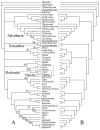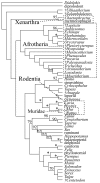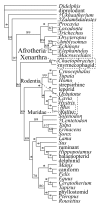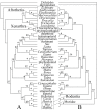A web-database of mammalian morphology and a reanalysis of placental phylogeny - PubMed (original) (raw)
A web-database of mammalian morphology and a reanalysis of placental phylogeny
Robert J Asher. BMC Evol Biol. 2007.
Abstract
Background: Recent publications concerning the interordinal phylogeny of placental mammals have converged on a common signal, consisting of four major radiations with some ambiguity regarding the placental root. The DNA data with which these relationships have been reconstructed are easily accessible from public databases; access to morphological characters is much more difficult. Here, I present a graphical web-database of morphological characters focusing on placental mammals, in tandem with a combined-data phylogenetic analysis of placental mammal phylogeny.
Results: The results reinforce the growing consensus regarding the extant placental mammal clades of Afrotheria, Xenarthra, Euarchontoglires, and Laurasiatheria. Unweighted parsimony applied to all DNA sequences and insertion-deletion (indel) characters of extant taxa alone support a placental root at murid rodents; combined with morphology this shifts to Afrotheria. Bayesian analyses of morphology, indels, and DNA support both a basal position for Afrotheria and the position of Cretaceous eutherians outside of crown Placentalia. Depending on treatment of third codon positions, the affinity of several fossils (Leptictis,Paleoparadoxia, Plesiorycteropus and Zalambdalestes) vary, highlighting the potential effect of sequence data on fossils for which such data are missing.
Conclusion: The combined dataset supports the location of the placental mammal root at Afrotheria or Xenarthra, not at Erinaceus or rodents. Even a small morphological dataset can have a marked influence on the location of the root in a combined-data analysis. Additional morphological data are desirable to better reconstruct the position of several fossil taxa; and the graphic-rich, web-based morphology data matrix presented here will make it easier to incorporate more taxa into a larger data matrix.
Figures
Figure 1
Optimal MP topologies, all data. Strict (A) and Adams (B) consensuses of 4 trees (49750 steps) resulting from combined morphology-DNA-indel dataset, all changes treated equally. Numbers indicate bootstrap support values (only reported above 50); asterisks indicate support of 100. Daggers indicate extinct taxa.
Figure 2
Optimal MP topologies, third positions removed. Strict consensus of 4 trees (27858 steps) resulting from combined morphology-DNA-indel dataset, excluding third positions from protein-coding genes. Numbers indicate bootstrap support values (only reported above 50); asterisks indicate support of 100. Daggers indicate extinct taxa.
Figure 3
Bayesian tree. Majority rule consensus of 15500 trees (1.6 million generations, sampled every 100, first 500 discarded as "burn-in") generated by MrBayes 3.1 [33]. Numbers indicate Bayesian posterior probability values; asterisks indicate support of 100. Daggers indicate extinct taxa.
Figure 4
Optimal MP topologies for Recent taxa alone. The analysis of morphology-DNA-indels (A) yields a single tree of 49588 steps with the placental root within Afrotheria. Using DNA-indels alone (B) yields two trees at 48530 steps with placental root at murid rodents. Numbers indicate bootstrap support values (only reported above 50); asterisks indicate support of 100.
Similar articles
- Phylogenomic data analyses provide evidence that Xenarthra and Afrotheria are sister groups.
Hallström BM, Kullberg M, Nilsson MA, Janke A. Hallström BM, et al. Mol Biol Evol. 2007 Sep;24(9):2059-68. doi: 10.1093/molbev/msm136. Epub 2007 Jul 13. Mol Biol Evol. 2007. PMID: 17630282 - The placental mammal ancestor and the post-K-Pg radiation of placentals.
O'Leary MA, Bloch JI, Flynn JJ, Gaudin TJ, Giallombardo A, Giannini NP, Goldberg SL, Kraatz BP, Luo ZX, Meng J, Ni X, Novacek MJ, Perini FA, Randall ZS, Rougier GW, Sargis EJ, Silcox MT, Simmons NB, Spaulding M, Velazco PM, Weksler M, Wible JR, Cirranello AL. O'Leary MA, et al. Science. 2013 Feb 8;339(6120):662-7. doi: 10.1126/science.1229237. Science. 2013. PMID: 23393258 - Resolution of the early placental mammal radiation using Bayesian phylogenetics.
Murphy WJ, Eizirik E, O'Brien SJ, Madsen O, Scally M, Douady CJ, Teeling E, Ryder OA, Stanhope MJ, de Jong WW, Springer MS. Murphy WJ, et al. Science. 2001 Dec 14;294(5550):2348-51. doi: 10.1126/science.1067179. Science. 2001. PMID: 11743200 - The chromosomes of Afrotheria and their bearing on mammalian genome evolution.
Svartman M, Stanyon R. Svartman M, et al. Cytogenet Genome Res. 2012;137(2-4):144-53. doi: 10.1159/000341387. Epub 2012 Aug 3. Cytogenet Genome Res. 2012. PMID: 22868637 Review. - Mammal madness: is the mammal tree of life not yet resolved?
Foley NM, Springer MS, Teeling EC. Foley NM, et al. Philos Trans R Soc Lond B Biol Sci. 2016 Jul 19;371(1699):20150140. doi: 10.1098/rstb.2015.0140. Philos Trans R Soc Lond B Biol Sci. 2016. PMID: 27325836 Free PMC article. Review.
Cited by
- Reconstructing mammalian phylogenies: a detailed comparison of the cytochrome B and cytochrome oxidase subunit I mitochondrial genes.
Tobe SS, Kitchener AC, Linacre AM. Tobe SS, et al. PLoS One. 2010 Nov 30;5(11):e14156. doi: 10.1371/journal.pone.0014156. PLoS One. 2010. PMID: 21152400 Free PMC article. - Phylogenetic Signal and Bias in Paleontology.
Asher RJ, Smith MR. Asher RJ, et al. Syst Biol. 2022 Jun 16;71(4):986-1008. doi: 10.1093/sysbio/syab072. Syst Biol. 2022. PMID: 34469583 Free PMC article. - Jaw anatomy of Potamogale velox (Tenrecidae, Afrotheria) with a focus on cranial arteries and the coronoid canal in mammals.
Brocklehurst RJ, Crumpton N, Button E, Asher RJ. Brocklehurst RJ, et al. PeerJ. 2016 Apr 12;4:e1906. doi: 10.7717/peerj.1906. eCollection 2016. PeerJ. 2016. PMID: 27114870 Free PMC article. - Taxonomic revision of the olingos (Bassaricyon), with description of a new species, the Olinguito.
Helgen KM, Pinto CM, Kays R, Helgen LE, Tsuchiya MT, Quinn A, Wilson DE, Maldonado JE. Helgen KM, et al. Zookeys. 2013 Aug 15;(324):1-83. doi: 10.3897/zookeys.324.5827. eCollection 2013. Zookeys. 2013. PMID: 24003317 Free PMC article. - The comparative osteology of the petrotympanic complex (ear region) of extant baleen whales (Cetacea: Mysticeti).
Ekdale EG, Berta A, Deméré TA. Ekdale EG, et al. PLoS One. 2011;6(6):e21311. doi: 10.1371/journal.pone.0021311. Epub 2011 Jun 22. PLoS One. 2011. PMID: 21731700 Free PMC article.
References
- McKenna MC. Toward a phylogeny and classification of the Mammalia. In: Luckett WP, Szalay FS, editor. Phylogeny of the Primates: a Multidisciplinary Approach. New York, Plenum; 1975. pp. 21–46.
- Novacek M. The Skull Of Leptictid Insectivorans And The Higher-Level Classification Of Eutherian Mammals. Bull Am Mus Nat Hist. 1986;183:1–111.
- Rowe T. Definition, diagnosis and origin of Mammalia. Journal of Vertebrate Paleontology. 1988;8:241–264.
- Gaudin TJ, Wible JR, Hopson JA, Turnbull WD. Reexamination of the morphological evidence for the Cohort Epitheria (Mammalia, Eutheria) Journal of Mammalian Evolution. 1996;3:31–79. doi: 10.1007/BF01454253. - DOI
- Cartmill M. Hypothesis testing and phylogenetic reconstruction. Z Zool Syst Evol. 1981;19:73–96.
Publication types
MeSH terms
LinkOut - more resources
Full Text Sources



